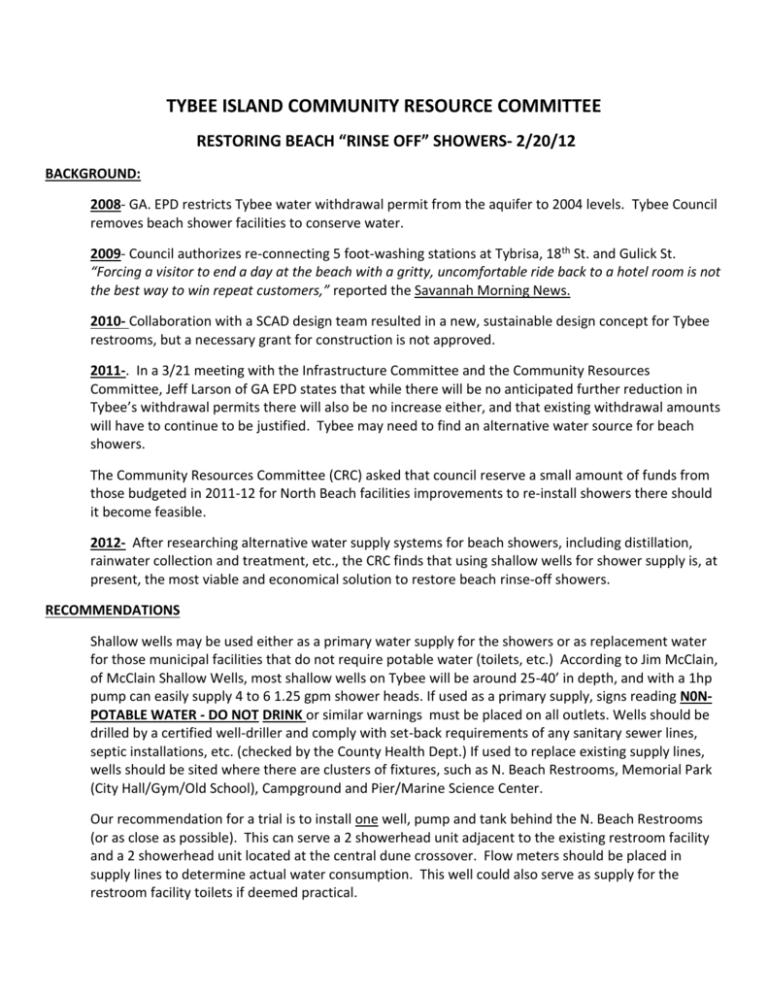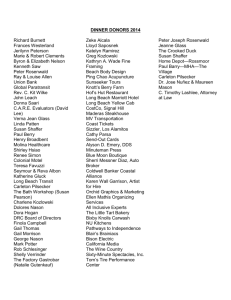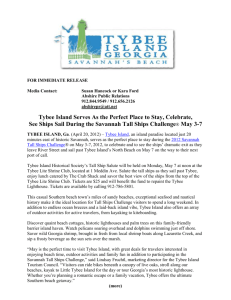electronic document
advertisement

TYBEE ISLAND COMMUNITY RESOURCE COMMITTEE RESTORING BEACH “RINSE OFF” SHOWERS- 2/20/12 BACKGROUND: 2008- GA. EPD restricts Tybee water withdrawal permit from the aquifer to 2004 levels. Tybee Council removes beach shower facilities to conserve water. 2009- Council authorizes re-connecting 5 foot-washing stations at Tybrisa, 18th St. and Gulick St. “Forcing a visitor to end a day at the beach with a gritty, uncomfortable ride back to a hotel room is not the best way to win repeat customers,” reported the Savannah Morning News. 2010- Collaboration with a SCAD design team resulted in a new, sustainable design concept for Tybee restrooms, but a necessary grant for construction is not approved. 2011-. In a 3/21 meeting with the Infrastructure Committee and the Community Resources Committee, Jeff Larson of GA EPD states that while there will be no anticipated further reduction in Tybee’s withdrawal permits there will also be no increase either, and that existing withdrawal amounts will have to continue to be justified. Tybee may need to find an alternative water source for beach showers. The Community Resources Committee (CRC) asked that council reserve a small amount of funds from those budgeted in 2011-12 for North Beach facilities improvements to re-install showers there should it become feasible. 2012- After researching alternative water supply systems for beach showers, including distillation, rainwater collection and treatment, etc., the CRC finds that using shallow wells for shower supply is, at present, the most viable and economical solution to restore beach rinse-off showers. RECOMMENDATIONS Shallow wells may be used either as a primary water supply for the showers or as replacement water for those municipal facilities that do not require potable water (toilets, etc.) According to Jim McClain, of McClain Shallow Wells, most shallow wells on Tybee will be around 25-40’ in depth, and with a 1hp pump can easily supply 4 to 6 1.25 gpm shower heads. If used as a primary supply, signs reading N0NPOTABLE WATER - DO NOT DRINK or similar warnings must be placed on all outlets. Wells should be drilled by a certified well-driller and comply with set-back requirements of any sanitary sewer lines, septic installations, etc. (checked by the County Health Dept.) If used to replace existing supply lines, wells should be sited where there are clusters of fixtures, such as N. Beach Restrooms, Memorial Park (City Hall/Gym/Old School), Campground and Pier/Marine Science Center. Our recommendation for a trial is to install one well, pump and tank behind the N. Beach Restrooms (or as close as possible). This can serve a 2 showerhead unit adjacent to the existing restroom facility and a 2 showerhead unit located at the central dune crossover. Flow meters should be placed in supply lines to determine actual water consumption. This well could also serve as supply for the restroom facility toilets if deemed practical. Shower units should have simple, low-flow heads and self-closing spring loaded valves, either cross handle or push button, with adequate drains consisting of a French drain system or piping allowing grey water to be used for area irrigation. (SEE ATTACHED SAMPLE DESIGNS, OPTIONS 1 & 2) COSTS: Well installation costs arise in 3 areas: initial capital costs, which includes well drilling, pump, wiring, tank and retrofitting supply lines to restrooms; maintenance & operation costs, including electricity for pumps, maintenance and monitoring of motors and filters, etc.; and possible costs due to aesthetic reasons (some shallow well water, untreated, may stain or corrode fixtures). While portions of the initial capital cost can be approximated (The costs for well drilling, pump & tank generally run around $1,700 per well, depending on depth) the cost of retrofitting supply lines is site specific and should be done by a licensed plumber or contractor. Likewise, maintenance and operations costs cannot be accurately estimated without a trial run. During periods of low rainfall, some shallow wells could dry up or pump sand or mud, necessitating frequent monitoring and changing of filters. FUNDING: It is important that Tybee continues its investment in visitor services infrastructure. Restroom upgrades, crossover replacements, updated signage, picnic and park area maintenance, etc. are all vital to ensure a positive experience for the Tybee visitor. Rinse-off showers are a necessary part of any public beachfront, and their engineering, design and construction should not be skimped on. Tybee spends tens of thousands to attract visitors, and receives hundreds of thousands in return from parking revenues, local business sales, etc. Beach showers should be properly funded and paid for from parking receipts, primarily those from the North and South Beach parking lots. Tybee’s DPW, particularly Water/Sewer, will need increased funding to allow for installation and proper maintenance of shower facilities. OPTION 1 BEACH SHOWER DESIGN- 1 UNIT= 2 SHOWERS (2-4 SHOWER HEADS) Unit Base: 4” Slab on grade fiber-reinforced concrete with exposed aggregate. Wherever possible, concrete recipe shall use sand or coloration that matches environmental conditions. Unit Drains: 24” Diameter high-density plastic (HDPE) ribbed riser pipe, 36” in length (min) installed in base and drilled with 1” holes every 4” (min) . Pipe to be lined with fabric filter cloth and filled with 5/8 to 1” washed drain rock to within 2” of finished floor level. Pipe to be capped with NYOPLAST ™ high density plastic pedestrian grate or similar, top of grate to be flush with S.O.G. deck. OPTIONAL DRAIN SYSTEM: Pipe wastewater to nearby planted areas for irrigation, or to cistern for use in toilet flushing, etc. Framing: 6X6 posts with 2X4 framing, OR one central 8X8 post. All lumber to be pressure treated for continuous ground contact. Fixtures & Shower Heads: Low-Flow shower heads (Bricor Ecofit-$29.95 or similar) at upper & lower shower head locations. Spring loaded, self-closing valves. Either cross- handle (King Supply # SCV1- $42), or push-button (King Supply #PBSC90V -$75) or similar. OPTIONS: Timed self closing valves (more complex & expensive- $135) or coinoperated valves (much more complex and expensive- $400). Neither of the options are recommended for beach use. Unit Cladding & Trim: IF used, All cladding & trim to be .375” King Starboard, UV stabilized, white (Interstate Plastics, 54”X96 @ $156. Per sheet) or similar, with access panel for valve maintenance and shut-off. Fasteners: All framing fasteners to be hot-dipped (HDG) galvanized. Cladding & trim fasteners to be #10 x1-1/4” stainless-steel tamper-proof wood screws w/stainless steel trim washers OPTION 2-HAND PUMP AND STAND FOR FOOT WASH OR BUCKET SHOWER SUPPORTING DOCUMENTS: BEACH SHOWER PROPOSALS 1. E-mail,Todd Jones, Chatham County Health Dept. to Don Ernst, re: beach showers 2. E-mail, Steve Fox, GA DNR to Don Ernst, re; beach showers 3. E-mail, George Reese, City of Tybee Island, to Don Ernst, Re; Beach Showers

![100_160_Agenda Request - Support Letter for NOAA Grant[Icon]](http://s3.studylib.net/store/data/007016778_1-0df323e637db9aa9776bf7dd8af5c65c-300x300.png)

![PERSONAL COMPUTERS CMPE 3 [Class # 20524]](http://s2.studylib.net/store/data/005319327_1-bc28b45eaf5c481cf19c91f412881c12-300x300.png)




